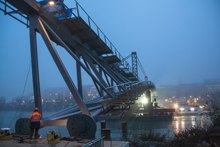Royal HaskoningDHV has worked with 3D printing equipment supplier CEAD and 3D-printing materials specialist DSM on the design. The team said that the combination of the PET material - Arnite - and the glass fibres that will be added during the 3D printing offers high strength with versatility and sustainability.

Maurice Kardas, business development manager at Royal HaskoningDHV, said: “FRP bridges are already well known for having a longer lifetime expectancy with lower life cycle costs compared to steel bridges. What’s new here is the use of a 3D printing technology, enabling us to print large-scale continuous fibre reinforced thermoplastic parts. Using this new composite thermoplastic material, we will be ushering in a new era for sustainability and push the boundaries of bridge functionality even further.”
He added: “By including sensors in the design, we are able to build a digital twin of the bridge. These sensors can predict and optimise maintenance, ensure safety and extend the life span of our bridges. It can also incorporate new functionalities such as monitoring vital environmental aspects and improve the decision-making process for maintenance and inspection via dynamic real-time reports on the condition of the bridge.
Patrick Duis, segment leader additive manufacturing at DSM added: “Using a material such as Arnite has huge benefits for the construction of bridges. Rather than using traditional materials such as steel or concrete, these bridges can be much more sustainable and offer greater flexibility in design using recyclable materials. We know that designs previously deemed challenging or impossible to produce with other manufacturing methods are now possible with 3D printing, and we’re excited to be playing our part in this partnership.”
Maarten Logtenberg, CEO of CEAD, said: “3D printing has evolved dramatically over the years. This 3D-printed bridge prototype demonstrates the huge strides that we are making which will transform the future of this industry, not only speeding up construction, but also making the process more cost and time efficient. We developed this technology for exactly these industry applications, making them more sustainable and easier to manufacture.”





